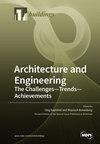A New Proposal for the Interpretation of the Diagonal Compression Test on Masonry Wallettes: The Identification of Young’s Modulus, Poisson’s Ratio, and Modulus of Rigidity
IF 3.1
3区 工程技术
Q2 CONSTRUCTION & BUILDING TECHNOLOGY
引用次数: 0
Abstract
This paper is the continuation of a previous study, which highlighted some inconsistencies in the RILEM guidelines for the interpretation of the diagonal compression test. Although improved compared to the ASTM guidelines, in fact, the RILEM guidelines underestimate the state of hydrostatic stress induced by the diagonal compression test at the center of the wallette. The new interpretation of the diagonal compression test proposed in this article shows that the RILEM guidelines actually underestimate both the hydrostatic and the deviatoric stress states at the center of the wallette. The new formulation complies with the linear elastic theory and allows us to use the diagonal compression test to identify the three elastic coefficients of masonry. In particular, it allows the identification of the Poisson ratio, which instead takes on a conventional value in the RILEM and ASTM guidelines. The difference of one order of magnitude between the conventional and proposed Poisson’s ratio is in agreement with the experimental results on another brittle material, namely concrete. Finally, the new proposal fills the gap between the results provided by the two tests usually performed to identify the shear behavior of masonry: the diagonal compression test and the shear-compression test.解释砌石瓦片对角线压缩试验的新建议:杨氏模量、泊松比和刚度模量的鉴定
本文是之前研究的延续,该研究强调了 RILEM 准则在解释对角线压缩试验时的一些不一致之处。虽然与 ASTM 准则相比有所改进,但事实上,RILEM 准则低估了对角线压缩试验在围檩中心引起的静水压力状态。本文提出的对角线压缩试验新解释表明,RILEM 准则实际上低估了 Wallette 中心的静水应力和偏差应力状态。新公式符合线性弹性理论,允许我们使用对角线压缩试验来确定砌体的三个弹性系数。特别是,它允许确定泊松比,而不是采用 RILEM 和 ASTM 准则中的传统值。传统泊松比与建议泊松比之间一个数量级的差异与另一种脆性材料(即混凝土)的实验结果一致。最后,新建议填补了通常用于确定砌体剪切行为的两种测试结果之间的空白:对角线压缩测试和剪切压缩测试。
本文章由计算机程序翻译,如有差异,请以英文原文为准。
求助全文
约1分钟内获得全文
求助全文
来源期刊

Buildings
Multiple-
CiteScore
3.40
自引率
26.30%
发文量
1883
审稿时长
11 weeks
期刊介绍:
BUILDINGS content is primarily staff-written and submitted information is evaluated by the editors for its value to the audience. Such information may be used in articles with appropriate attribution to the source. The editorial staff considers information on the following topics: -Issues directed at building owners and facility managers in North America -Issues relevant to existing buildings, including retrofits, maintenance and modernization -Solution-based content, such as tips and tricks -New construction but only with an eye to issues involving maintenance and operation We generally do not review the following topics because these are not relevant to our readers: -Information on the residential market with the exception of multifamily buildings -International news unrelated to the North American market -Real estate market updates or construction updates
 求助内容:
求助内容: 应助结果提醒方式:
应助结果提醒方式:


